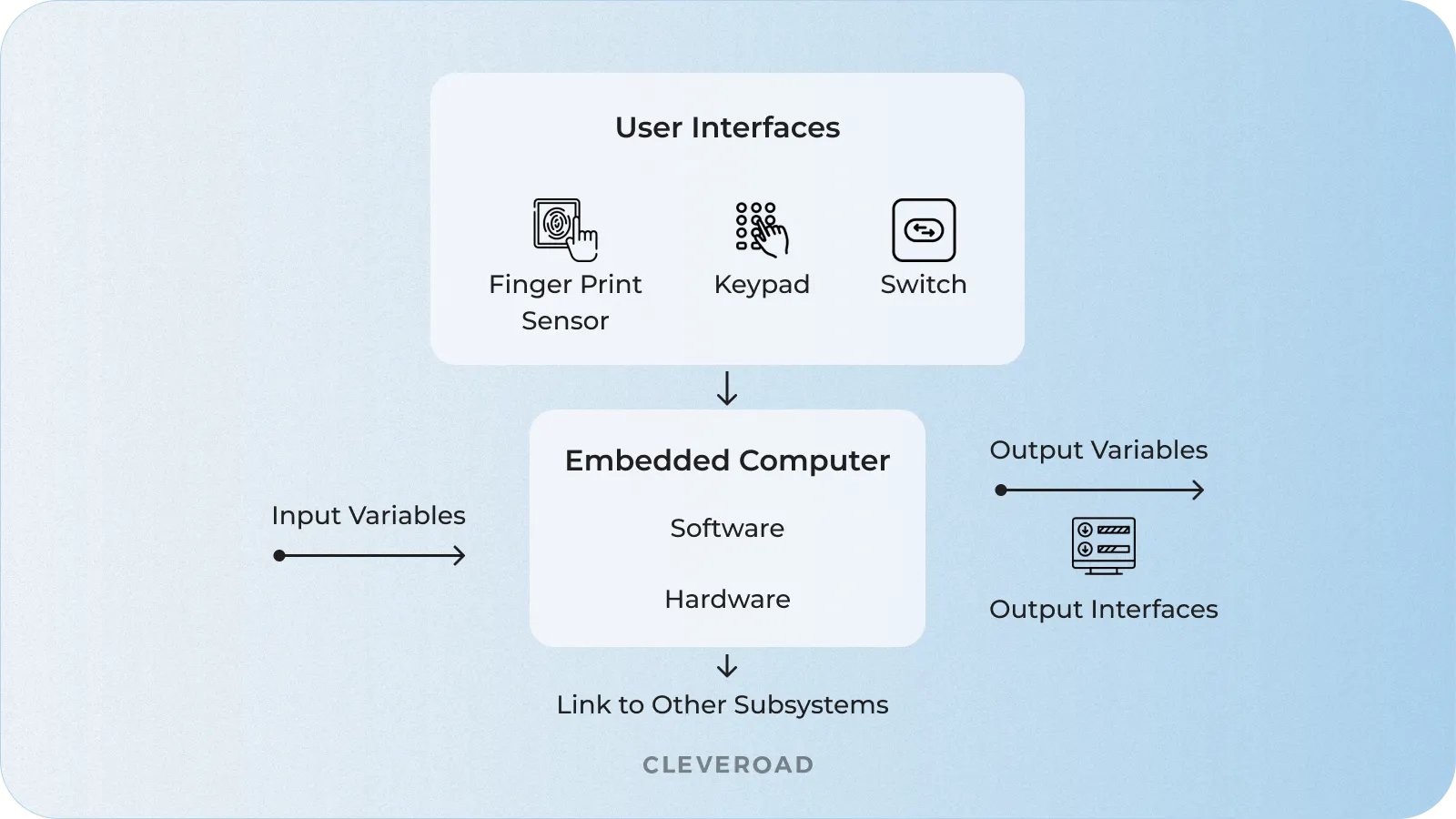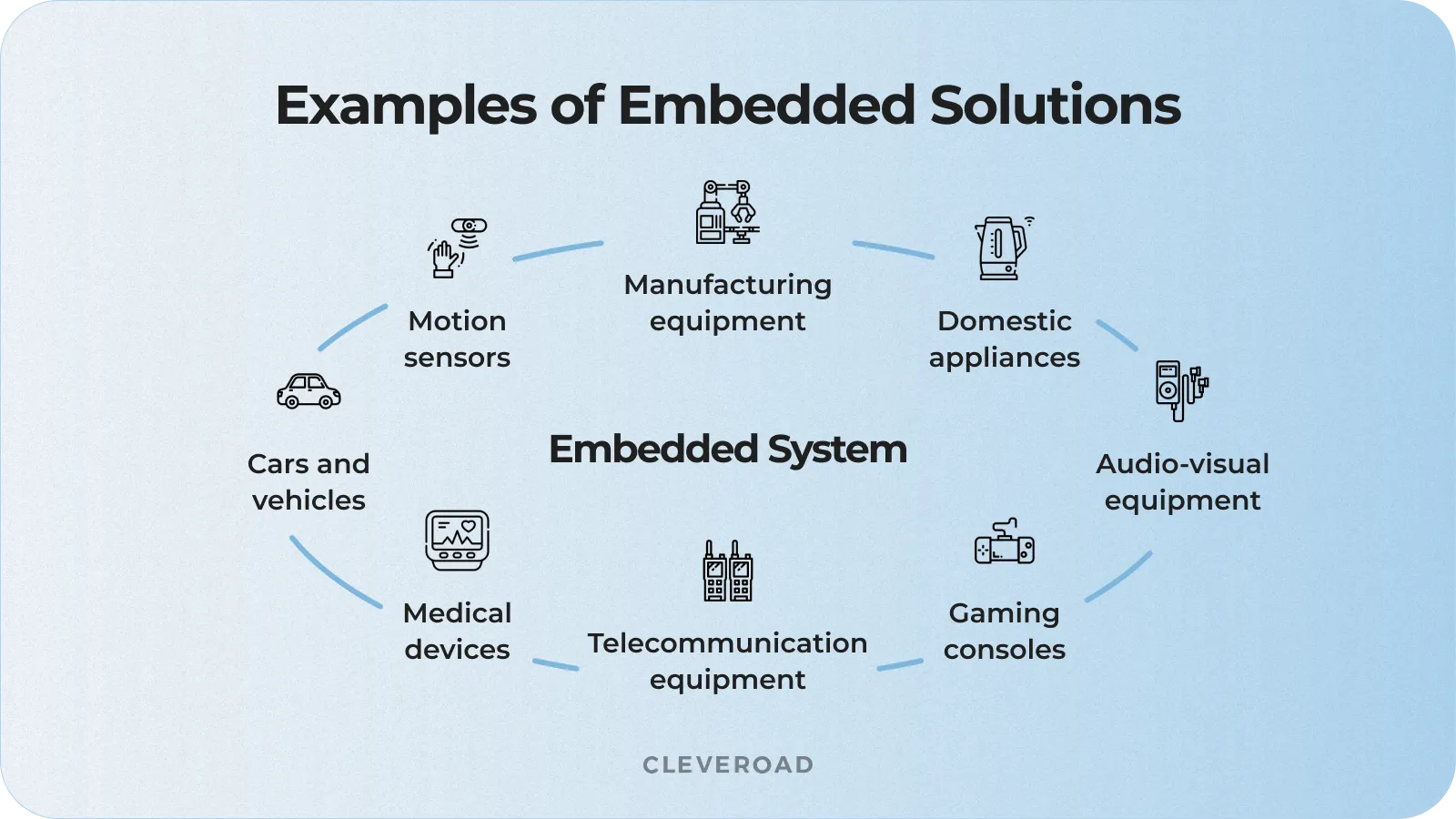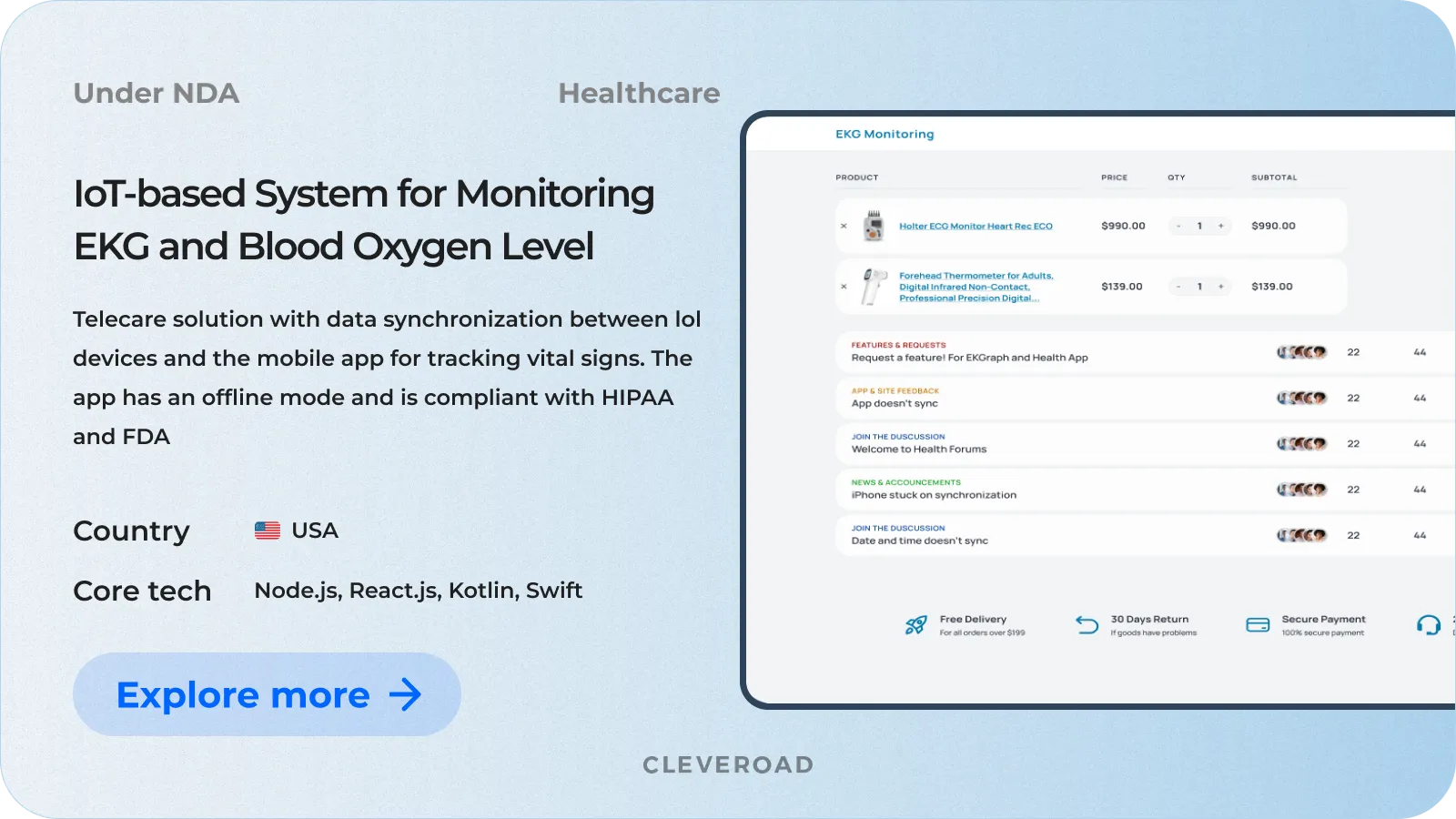Navigating Opportunities in Embedded System Software Development
18 Jul 2023
11 Min
643 Views
Embedded software is a solution specifically designed to run on embedded systems or hardware devices, providing high efficiency and precision control in various industries. Embedded software allows you to interact with hardware components, optimize resources and implement real-time solutions. The effectiveness of embedded solutions for business is manifested in the ability to create compact and powerful systems that can process data quickly and accurately. Moreover, embedded software development opens new opportunities for innovation in various industries, helping enterprises to achieve high efficiency and functionality.
In this article, we will open to you all the specific features of embedded systems development, discuss how to create such solutions, and explore the main benefits and challenges.
What Is Embedded Systems Development?
The development of embedded systems is the creation of software for systems embedded in various devices to control their functionality. This can be microcontrollers, microprocessors, programmable logic controllers (PLCs), and other hardware platforms. Embedded software is used in various industries, including automotive, smart homes and cities, healthcare, space projects, and the military.
Embedded software is integral to the functioning of the device it operates on. It aims to ensure the fulfillment of device operation and all necessary functions and tasks. Such systems must operate in real-time, quickly responding to specific requests. They are also tailored to the device's technical features and are often designed to utilize limited resources such as memory, processing consumption of power.
How embedded systems work
Embedded systems are a complex interplay of software and hardware. They consist of microprocessors, microcontrollers, memory, I/O, and power supplies that synchronize to perform their tasks.
The mechanism of operation of embedded systems is based on software-hardware interaction. Hardware components receive commands from software that tell them how to process input data, perform calculations, and communicate with other devices through communication interfaces. The software is programmed on specialized printed-circuit boards instructing the hardware to perform tasks. This allows embedded systems to perform their functions in real-time and provide users with the necessary output.

How embedded systems work
Embedded software examples
The development of embedded systems is used in many industries and devices. Let's take a look at some of the most common examples of such software applications:
Automotive systems. Embedded systems development is vital part of creating reliable and functional automobiles, as it helps to build engine management systems, control and navigation systems, anti-lock brake systems (ABS), adaptive cruise control, and many others.
Smart Home and Internet of Things (IoT). IoT technology would only have appeared with embedded system development, as all devices that interact with each other and the user use embedded software. For example, smart locks, thermostats, lighting, and others.
Medical devices. Many devices used in clinics, for example, ECG machines, defibrillators, and implantable medical devices, are also provided with functionality using embedded software development.
Household appliances. Embedded application development is used even in household appliances, such as refrigerators, washing machines, and televisions, providing automation and control.
Industrial automation. Industrial automation systems such as PLCs (Programmable Logic Controllers), production control systems, energy management systems, security, and access control systems are also provided with embedded software development.
Aerospace and military industries. Embedded software development also powers these industries' navigation systems, autopilots, control systems, radar, communications management, and other critical for these industries systems.

Embedded systems examples
These are not all examples of software development for embedded systems, as almost every device or system that requires reliable and optimized management and control functionality uses embedded software.
Essential components of embedded systems
Embedded system development requires several components to ensure its functionality and smooth operation. Among them:
- Microcontrollers - integrated circuits that integrate the processor, memory, and peripherals. They provide the basic control and execution of tasks.
- Peripherals include sensors, transducers, communication modules (e.g., Wi-Fi, Bluetooth), displays, and other components that allow the system to interact with the environment.
- Additional memory expansion devices, such as external SD cards, allow for storing more data.
- An operating system optimized for specific requirements efficiently uses the device's limited resources.
- A software developer kit (SDK) provides tools, libraries, and development environments that allow you to create quality software.
- Communication protocols enable devices to communicate with each other and the central system.
- User interfaces allow direct interaction with the device and depend on specific features and needs.
These are just some of the necessary components for embedded systems, and specific requirements may vary depending on the application and system functionality.
Success Stories of Developing Embedded Systems: Cleveroad Experience
The Cleveroad team has experience successfully creating and implementing embedded software for the healthcare industry. We want to present you one of the cases with IoT integration.
IoT-based monitoring system
Our client is a US-based organization that manufactures and sells medical IoT hardware, particularly ECG heart monitoring devices and pulse oximeters. The company approached us to help them create a telemedicine solution integrated with IoT devices tracking heart rate and blood oxygen levels from users smartphones.
Our team developed two native mobile apps (iOS and Android) connected to IoT devices via Bluetooth. The system wirelessly receives and processes data and gives users information about their biological indicators. These IoT devices contain two FDA-cleared sensors to obtain health data: the main one is the EKG monitor, and the second one is the pulse oximeter. Devices' software upgrades are also provided: the app checks them when connected to hardware and, if available, offers them to users.
As a result, the client received a telecare embedded system with data synchronization allowing for tracking vital signs like heart activity and blood oxygen level. About 95% of users rate it with "4-5 stars". The platform also receives positive feedback from healthcare providers.
How to Develop Embedded Software
Creating embedded software involves several important steps. Let's take a closer look at the embedded software development process:
1. Finding an IT provider and choosing a cooperation model
Cooperating with a professional software provider with experience in embedded software development is crucial. When choosing a software provider, pay special attention to their expertise in your business domain, and experience in embedded systems development. Also, pay special attention to customer reviews on platforms such as Clutch. This point will give you more information about the service quality. Finding qualified specialists in your city or country may be difficult, so embedded software development outsourcing or outstaffing is a good option.
Outstaffing is perfect for you if you already have your development team, but need one or more embedded engineers to augment your team with required expertise. . You can hire third-party experts to work on your product, which will help you save time and costs compared to hiring permanent in-house staff.
Outsourcing allows you to hire an entire team of specialists to develop an embedded system. It is an excellent option if you prefer to save time and costs on hiring an in-house team Moreover, outsourcing allows you to leave the project management to specialists and get a finished product of the highest quality as a result. By contacting a proficient software vendor, you will get a team of pre-screened engineers who will help you complete the project in the shortest time with guaranteed quality.
2. Requirements gathering
Before embarking on embedded system development, your tech provider must detail the software demands. Requirements gathering is a key step, as properly understanding and documenting requirements provides the foundation for successful development and satisfying needs. This will require identifying the system's required functionality and considering non-functional requirements such as performance, reliability, security, scalability, maintainability, and other system attributes. It is also critical to consider device limitations such as memory, power consumption, etc.
3. Design and architecture selection
The next step is to select a proper and solid architecture. Depending on your needs, solution architects can offer you optimal architecture, considering project complexity, performance, real-time demands, resource availability (e.g., power, memory, storage, and energy), and more. The team will identify the system’s main components and build algorithms and data structures to implement the functionality of each embedded system’s element and determine how the system will manage its state, resources, and data.
Explore how to hire remote developers for your project
4. Development and implementation
Once your software provider’s team defines and details all the requirements, the developers will move on to embedded system development. At this stage, they will develop code, modules, libraries, and other components to implement the embedded system's functionality. Professional software vendors often use Agile methodology for building embedded systems. After completing the product, the team moves on to implementing the software on the target hardware platform. The team carefully selects development toolkits and programming languages to ensure that the system is completely compliant.
Our developers can offer you the most relevant toolkits for embedded software development based on their personal experience:
- Version Control Software (VCS) is used to track code changes in different versions and allows multiple developers to work on the project simultaneously
- Compilers help to transform code into a machine-understandable language
- An Automation Tool will enable you to automate some of the steps of building, testing, and deploying using a CI/CD process
- Static Code Analysis tool will allow you to detect defects, weaknesses, and compliance issues efficiently
As for programming languages for embedded systems development, traditionally, experts use C and C++. Also, quite often, they turn to C# or Assembly. However, programming languages like Java, Python, JavaScript, Embedded C++, and many others are also used to develop embedded systems.
5. Hardware and software integration
Hardware and software integration brings together the components of an embedded system and ensures that they work together to achieve stable and reliable functionality. This process includes defining interfaces, developing drivers and interface software, integrating software with hardware, and testing and optimizing system performance.
6. Testing
During the development and integration process and after completion, QA engineers pay a lot of attention to conducting various tests. These include functional testing, unit testing, integration testing, and other types of testing. Running these tests helps to verify the operability, reliability, and compliance of the embedded software.
7. Support
To ensure that your system with embedded software works correctly, it is necessary to continue cooperation with the IT provider after its implementation. Specialists will continuously monitor the system's performance and make fixes and updates as needed. Moreover, an experienced provider will help provide ongoing support and maintenance as part of software development services.
Pitfalls of Embedded Software Development You Must be Prepared For
Embedded software development is associated with some difficulties caused by the peculiarities of such systems. Let's look at the main challenges and how you can overcome them:
Security
Often embedded systems, especially those related to the Internet of Things (IoT) technology, can be exposed to additional security threats such as unauthorized access, hacking, and cyberattacks. Strong protocol and data encryption techniques and sophisticated authentication and authorization methods can be employed to provide such systems with greater protection.
Real-time operation
Some embedded systems require real-time tasks with certain time constraints. Ensuring accurate and predictable execution can be challenging. Developers use scheduling algorithms, task priority management, performance optimization, and real-time operating systems to cope with this challenge.
Resource constraints
Embedded systems are often limited in important resources such as memory, power consumption, or Central Processing Unit (CPU) time - the amount of time that the CPU spends executing a specific task or program. As a consequence, their capabilities may also be limited. However, experienced developers get around this difficulty by optimizing code, using efficient algorithms and hardware solutions, and planning resource usage more carefully.
Cleveroad Experience in Embedded System Development
Cleveroad is a professional software development company with 11+ years of experience in IT. Our team also has hands-on experience in embedded software development, including IoT-based solutions, communication systems, data visualization systems, etc.
By partnering with Cleveroad, you will get:
- Full-fledged embedded software development services: analysis, embedded hardware development, system integration, security implementation, etc.
- On-demand specialized services: IoT implementation, visualization tool integration, legacy system modernization, IT consulting, etc.
- Experienced team with expertise in multiple industries, including FinTech, Healthcare, Logistics, Media, Travel, and others
- Detailed consultation with our Solution Architect on all necessary steps for embedded software implementation
- Flexible cooperation models based on your needs: Dedicated Team, Outstaffing, Time & Materials, and Fixed Workscope
- Utilization of modern and appropriate programming languages and integrations suited to your project requirements
- In-depth quality assurance at all stages of embedded software engineering
If you need to build an embedded system, do not hesitate to contact us! Our Business Development manager will consult you on all questions to help you deliver a quality solution to ensure reliable and fail-safe operation in real-time
Need embedded system?
Our team will help you make an embedded system to connect devices and sharing data across networks
Embedded software development is creating software designed to run in embedded systems, specialized computer systems integrated into larger devices or products. It involves writing code that allows these systems to perform certain functions and interact with hardware components. Embedded software is usually optimized for efficiency, reliability, and real-time operation because it often controls critical roles in various industries such as automotive, aerospace, medical, and consumer electronics.
For successful embedded software development, your first step is to find an experienced software provider to help you with the rest. Then, in the embedded software development process, the software provider will structure all project requirements, select the right architecture and technologies, design and implement the best quality embedded system for you. Relying on the software vendor ensures collaboration, documentation, and adherence to industry standards, resulting in successful embedded software development.
An example of embedded software development is the creation of software for a car's engine control unit (ECU), telemedicine device monitoring system, GPS tracking and fleet management solution, household appliances, smart houses, etc. At Cleveroad, we had experience creating embedded software for a hardware IoT product that monitors the hydration level in a human organism. Explore our IoT-based system case in more detail
Common programming languages used in embedded software development include C, C++, and Assembly language. These languages offer low-level control and efficient resource utilization, making them well-suited for programming the hardware components of embedded systems. Additionally, languages like Python and Java are sometimes used for higher-level tasks in embedded systems that require greater abstraction.

Evgeniy Altynpara is a CTO and member of the Forbes Councils’ community of tech professionals. He is an expert in software development and technological entrepreneurship and has 10+years of experience in digital transformation consulting in Healthcare, FinTech, Supply Chain and Logistics
Give us your impressions about this article
Give us your impressions about this article
